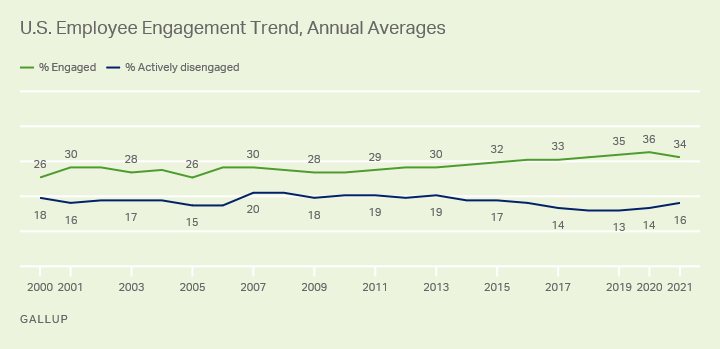The Permissible Disease of the Workplace
Although it costs many workplaces hundreds of thousands per year, employee disengagement seems to be the permissable disease of the workplace.
Photo by Tiger Lily on Pexels
In our previous post, we discovered that although it was easy to blame the Great Resignation of employees on the pandemic, that wasn’t the actual cause. The real cause of the unprecedented numbers of employees voluntarily leaving their workplaces was employee disengagement. Now that workplaces are returning to normal (albeit a new normal), should they be concerned about employee disengagement?
According to Gallup, only 34% of American employees are engaged. That means 66% of them are disengaged at some level.
There are three types of employees when it comes to engagement:
Engaged employees are committed, dedicated, and emotionally connected to their work and workplace and are willing to give their best, discretionary effort
Disengaged employees may be physically present but are only doing the minimum work required
Actively disengaged employees are spreading their misery to others
If only 34% are engaged, then most workers are performing minimally or are bringing others down with them.
But as the Gallup data show, majority disengagement in the workplace has been happening for some time. Over the last 20 years, the national average hasn’t changed that much.
Source: https://www.gallup.com/workplace/388481/employee-engagement-drops-first-year-decade.aspx
Why is that? Do workplaces consider disengagement a problem to solve? Sure, there has been some rise in the national engagement score, but does this minimal improvement indicate true seriousness when addressing this issue?
If 66% of employees were stealing company resources, would the company let it slide?
If 66% of employees resigned in one day, would the company shrug it off?
If 66% of employees got cancer from the building materials, would the company ignore it?
Then why is the national average still at 66%? Employee disengagement is the permissible disease of the workplace.
Consider these figures. According to Forbes magazine, the cost of disengagement is $3,400 for every $10,000 of salary.
This means that:
For a salary of $47,000, that’s $15,980 per year
For a salary of $60,000, that’s $20,400 per year
For a salary of $80,000, that’s $27,200 per year
This is the cost for one employee for one year. Imagine an organization with 66% disengaged employees over multiple years.
If you have 50 employees earning $47,000 per year, disengagement is costing you $800,000 per year.
When you start a new year, you can throw another $800,000 in the trash. If your company was wasting $800,000 each year, you’d try hard to avoid that wasted cost, wouldn’t you?
What else could you do with that money?
If you’re a school, pay your teachers more
If you’re a technology company, hire more programmers
If you’re a nonprofit, direct more money to your mission
You get the point. Wasted cost is not just money in the trash, it’s wasted opportunity for the expenditures that really matter.
Why is employee disengagement the permissible disease of the workplace? Why do most workplaces lack a proactive engagement strategy? Why is this problem allowed to fester?





